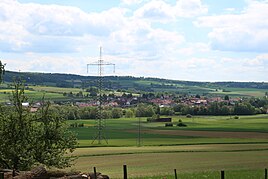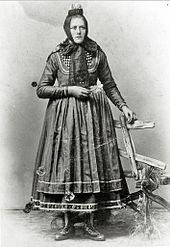Hachborn
|
Hachborn
municipality Ebsdorfergrund
Coordinates: 50 ° 43 ′ 14 " N , 8 ° 47 ′ 28" E
|
|
|---|---|
| Height : | 207 (193-223) m above sea level NHN |
| Area : | 9.83 km² |
| Residents : | 1200 |
| Population density : | 122 inhabitants / km² |
| Incorporation : | July 1, 1974 |
| Postal code : | 35085 |
| Area code : | 06424 |
|
View from the north
|
|
Hachborn is a district on the western edge of the municipality Ebsdorfergrund in the central Hessian district of Marburg-Biedenkopf . The place has around 1200 inhabitants.
Local division
Until the incorporation, the community consisted of the core town of Hachborn and the settlement areas:
- Sand mill
- Strassmühle
- Gold mill
- Fortbach
history
The first documentary mention of Hachborn took place around 1130 under the place name Habechenbrunnun. 1151 the Hachborn local nobility "Volpertus de Habekebrunnin" testified that the newly built Beltershausen church was separated from the parish in Ebsdorf. Around this time the landlords of the village were the Counts of Gleiberg , in 1163 it was Giso and Hartrad von Merenberg .
In 1834, with the creation of local self-government, Hachborn became an independent municipality, and in 1866 the Fortbach estate was incorporated into Hachborn. On December 1, 1900 the village had 705 inhabitants.
Territorial reform
1 July 1974 at Hachborn lost as part of the municipal reform in Hesse independence and were with the previously independent municipalities also Ebsdorfergrund, Beltershausen, Ebsdorf Ilschhausen, suffering Hofen and Rauischholzhausen by state law to the new greater community Ebsdorfergrund together .
Territorial history and administration
The following list gives an overview of the territories in which Hachborn was located and the administrative units to which it was subordinate:
- before 1567: Holy Roman Empire , Landgraviate of Hesse , Ebsdorf court (Ebsdorf court consisted of the following places: Ebsdorf, Leidenhofen, Hachborn, Erbenhausen, Hassenhausen, Ilschhausen, Roßberg, Dreihausen, Möln and Heskem)
- from 1567: Holy Roman Empire, Landgraviate Hessen-Marburg , Marburg Office , Ebsdorf Court
- 1604–1648: Holy Roman Empire, disputed between Landgraviate Hessen-Darmstadt and Landgraviate Hessen-Kassel ( Hessian War ), Marburg Office, Ebsdorf Court
- from 1648: Holy Roman Empire, Landgraviate Hessen-Kassel, Marburg Office, Ebsdorf Court
- from 1786: Holy Roman Empire, Landgraviate Hessen-Kassel, Amt Treis an der Lumbde , Ebsdorf court
- from 1803: Holy Roman Empire, Electorate of Hesse , Amt Treis an der Lumbde, Ebsdorf court
- from 1806: Electorate of Hesse, Amt Treis an der Lumbde, Ebsdorf court
- 1807–1813: Kingdom of Westphalia , department of Werra , district of Marburg , canton of Ebsdorf
- from 1815: German Confederation , Electorate of Hesse, Amt Treis an der Lumbde, Court of Ebsdorf
- from 1821: German Confederation, Electorate of Hesse, Province of Upper Hesse , District of Marburg (separation of justice ( district court Marburg ) and administration)
- from 1848: German Confederation, Electorate of Hesse, Marburg district
- from 1851: German Confederation, Electorate of Hesse, Province of Upper Hesse, District of Marburg
- from 1866: North German Confederation , Kingdom of Prussia , Province of Hesse-Nassau , District of Kassel , District of Marburg
- from 1871: German Empire , Kingdom of Prussia, Province of Hessen-Nassau, District of Kassel, District of Marburg
- from 1918: German Empire, Free State of Prussia , Province of Hessen-Nassau, Administrative Region of Kassel, District of Marburg
- from 1944: German Empire, Free State of Prussia, Province of Kurhessen , District of Marburg
- from 1945: American zone of occupation , Greater Hesse , Kassel district, Marburg district
- from 1949: Federal Republic of Germany , State of Hesse , Kassel district, Marburg district
- on July 1, 1974, Hachborn was incorporated as a district of the newly founded municipality Ebsdorfergrund.
- 1974: Federal Republic of Germany, Land Hessen, Kassel , Marburg-Biedenkopf
- from 1981: Federal Republic of Germany, State of Hesse, Gießen district, Marburg-Biedenkopf district
Courts since 1821
With an edict of June 29, 1821, administration and justice were separated in Kurhessen. Now judicial offices were responsible for the first instance jurisdiction, the administration was taken over by the districts. The district of Marburg was responsible for the administration and the Marburg district court was the court of first instance for Hachborn. In 1850 the regional court was renamed the Marburg Justice Office. The Supreme Court was the Higher Appeal Court in Kassel . The higher court of Marburg was subordinate to the province of Upper Hesse. It was the second instance for the judicial offices. With the law on the reorganization of lower court districts of July 13, 1833, Hachborn was assigned to the Treis an der Lumda justice office .
After the annexation of Kurhessen by Prussia, Treis was ceded to the Grand Duchy of Hesse through an area swap , Hachborn was added to the Marburg Justice Office, which has now become the Royal Prussian District Court of Marburg . In June 1867, a royal ordinance was issued that reorganized the court system in the areas that belonged to the former Electorate of Hesse. The previous judicial authorities were to be repealed and replaced by local courts in the first, district courts in the second and an appeal court in the third instance. In the course of this, on September 1, 1867, the previous judicial office was renamed the Marburg District Court. The courts of the higher authorities were the Marburg District Court and the Kassel Court of Appeal .
Even with the entry into force of the Courts Constitution Act of 1879, the district court remained under his name. In the Federal Republic of Germany, the superordinate instances are the Marburg Regional Court , the Frankfurt am Main Higher Regional Court and the Federal Court of Justice as the last instance.
population
Population development
Occupied population figures are:
| • 1467: | 32 house seats |
| • 1577: | 47 house seats |
| • 1630: | 10 farm workers (1 four-horse, 3 three-horse, 4 two-horse, 2 single-horse farm workers). Several men died from the plague. |
| • 1681: | 37 home-seated teams |
| • 1747: | 54 house seats |
| • 1838: | 632 inhabitants (45 local residents who are entitled to use, 38 residents who are not entitled to use, 22 residents ). |
| Hachborn: Population from 1768 to 1967 | ||||
|---|---|---|---|---|
| year | Residents | |||
| 1768 | 356 | |||
| 1834 | 597 | |||
| 1840 | 602 | |||
| 1846 | 658 | |||
| 1852 | 703 | |||
| 1858 | 685 | |||
| 1864 | 684 | |||
| 1871 | 649 | |||
| 1875 | 665 | |||
| 1885 | 692 | |||
| 1895 | 669 | |||
| 1905 | 654 | |||
| 1910 | 661 | |||
| 1925 | 701 | |||
| 1939 | 717 | |||
| 1946 | 945 | |||
| 1950 | 1.004 | |||
| 1956 | 886 | |||
| 1961 | 910 | |||
| 1967 | 973 | |||
| Data source: Historical municipality register for Hesse: The population of the municipalities from 1834 to 1967. Wiesbaden: Hessisches Statistisches Landesamt, 1968. Other sources: | ||||
Religious affiliation
Source: Historical local dictionary
| • 1861: | 670 Evangelical-Lutheran , 15 Evangelical-Reformed inhabitants. |
| • 1885: | 665 Protestant (= 96.10%), no Catholic, 27 other Christians (= 3.90%) |
| • 1961: | 852 Protestant (= 93.63%), 55 Catholic (= 6.04%) residents |
Gainful employment
Source: Historical local dictionary
| • 1768: | Labor force: 3 blacksmiths, 1 carpenter, 1 turner, 2 shoemakers, 1 wagner, 2 tailors, 8 linen weavers, 3 carpenters, 3 day laborers, 7 day laborers. |
| • 1838: | Families: 47 arable farming, 28 trades, 30 day laborers. |
| • 1961: | Labor force: 205 agriculture and forestry, 137 manufacturing, 47 trade and transport, 52 services and other. |
Attractions
- The monastery wall near the village church
- Rest of the monastery wall in Hachborner Strasse
- Klosterkeller (private property)
- Today as Ev. Church used former monastery church
- The old village fountain / The Born
- The Schwedenstein
- Old hill
- New hill
- Barrows
- Biotope on the Zwester Ohm
- Fortbach estate
Infrastructure
There is a primary school and a kindergarten in Hachborn. There are several clubs in the village, including a singing club, a motorcycle club and a sports club.
literature
- Valentin Sussmann: Hachborner Chronik 1151–1954 . Hachborn 1954 (Festschrift MGV)
- Peter Lemmer: Hachborner Chronik 1954–1969 . Hachborn 1969 (Festschrift MGV)
- Literature about Hachborn in the Hessian Bibliography
- Search for Hachborn in the archive portal-D of the German Digital Library
Web links
- District Hachborn. In: Internet presence. Ebsdorfergrund community
- Hachborn, Marburg-Biedenkopf district. Historical local dictionary for Hessen. In: Landesgeschichtliches Informationssystem Hessen (LAGIS).
Individual evidence
- ↑ a b c d e f g Hachborn, Marburg-Biedenkopf district. Historical local dictionary for Hessen. (As of February 28, 2017). In: Landesgeschichtliches Informationssystem Hessen (LAGIS).
- ↑ The district on the website of the municipality of Ebsdorfergrund , accessed in August 2015
- ↑ Law on the reorganization of the Biedenkopf and Marburg districts and the city of Marburg (Lahn) (GVBl. II 330-27) of March 12, 1974 . In: The Hessian Minister of the Interior (ed.): Law and Ordinance Gazette for the State of Hesse . 1974 No. 9 , p. 154 , § 13 ( online at the information system of the Hessian state parliament [PDF; 3.0 MB ]).
- ^ Federal Statistical Office (ed.): Historical municipality directory for the Federal Republic of Germany. Name, border and key number changes in municipalities, counties and administrative districts from May 27, 1970 to December 31, 1982 . W. Kohlhammer, Stuttgart / Mainz 1983, ISBN 3-17-003263-1 , p. 403 .
- ^ Michael Rademacher: German administrative history from the unification of the empire in 1871 to the reunification in 1990. State of Hesse. (Online material for the dissertation, Osnabrück 2006).
- ^ Georg Landau: Description of the Electorate of Hesse . T. Fischer, Kassel 1842, p. 387 ( online at HathiTrust's digital library ).
- ^ The affiliation of the Treis office based on maps from the Historical Atlas of Hessen : Hessen-Marburg 1567–1604 . , Hessen-Kassel and Hessen-Darmstadt 1604–1638 . and Hessen-Darmstadt 1567–1866 .
- ^ Kur-Hessischer Staats- und Adress-Kalender: 1818 . Publishing house d. Orphanage, Kassel 1818, p. 121–123 ( online at Google Books ).
- ↑ Ordinance of August 30th, 1821, concerning the new division of the area , Annex: Overview of the new division of the Electorate of Hesse according to provinces, districts and judicial districts. Collection of laws etc. for the Electoral Hesse states. Year 1821 - No. XV. - August., ( Kurhess GS 1821) pp. 223-224
- ↑ Latest news from Meklenburg / Kur-Hessen, Hessen-Darmstadt and the free cities, edited from the best sources. in the publishing house of the GHG privil. Landes-Industrie-Comptouts., Weimar 1823, p. 158 ff . ( online at HathiTrust's digital library ).
- ↑ KurhessGesSamml. 1833, p. 129 ( online )
- ↑ Ordinance on the constitution of the courts in the former Electorate of Hesse and the formerly Royal Bavarian territories with the exclusion of the enclave Kaulsdorf from June 19, 1867. ( PrGS 1867, pp. 1085-1094 )
- ↑ Order of August 7, 1867, regarding the establishment of the according to the Most High Ordinance of June 19 of this year. J. in the former Electorate of Hesse and the formerly Royal Bavarian territorial parts with the exclusion of the enclave Kaulsdorf, courts to be formed ( Pr. JMBl. Pp. 221–224 )


